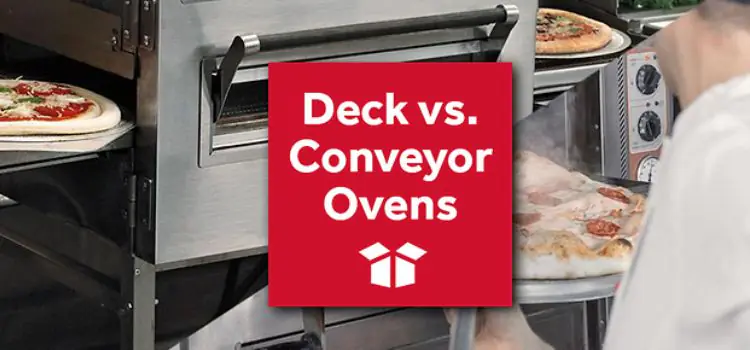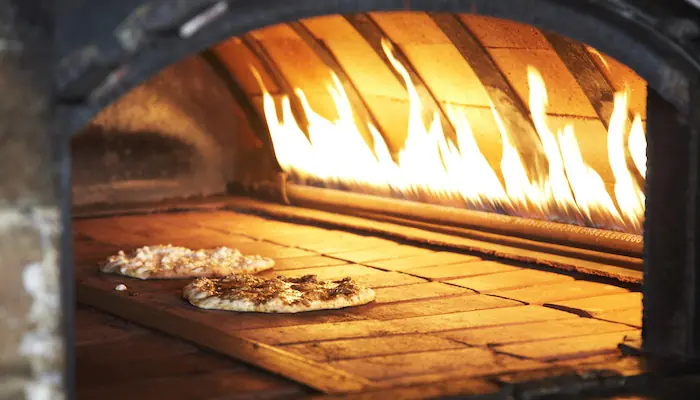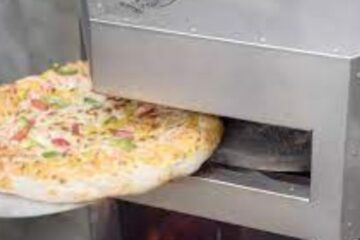Conveyor Pizza Oven Vs Deck Oven: Conveyor pizza ovens use a continuous belt to cook pizzas, while deck ovens have stationary shelves. Choosing between a conveyor pizza oven and a deck oven depends on factors such as output, space, and desired pizza style.
Each type offers unique benefits and drawbacks that cater to different restaurant needs and pizza-making techniques. Differentiating between them aids in informed decisions that match specific business needs and goals. This article will explore the features, advantages, and considerations of conveyor pizza ovens and deck ovens to help you decide which is the best fit for your pizzeria or restaurant.
Whether you prioritize speed, consistency, or traditional artisanal methods, selecting the right oven can significantly impact the quality and efficiency of your pizza operations.
Understanding The Mechanics of Conveyor Pizza Oven Vs Deck Oven
When it comes to choosing a pizza oven, understanding the mechanics of conveyor and deck ovens is crucial. Each type of oven operates differently and can have significant implications for the quality and consistency of the pizzas produced. Uncover the workings of conveyor and deck ovens in this article, aiding your informed decision-making for the ideal pizzeria choice.
Conveyor Pizza Oven Operation
A conveyor pizza oven operates on a continuous cooking process, allowing pizzas to move through the oven on a conveyor belt. The heat source is located on top and bottom, ensuring consistent and even cooking. As the pizzas travel through the oven, they are exposed to consistent heat, resulting in uniform and quick cooking. This method is ideal for high-volume pizza production, as it enables a constant flow of pizzas with minimal supervision.
Deck Oven Operation
In contrast, a deck oven operates using individual decks or shelves where pizzas are placed for baking. These decks are heated from the bottom, creating a radiant heat that cooks the pizzas. The heat distribution in a deck oven is more localized, allowing for precise control over the cooking process. Ensure uniform cooking by manually rotating or moving pizzas in the oven, requiring a hands-on approach distinct from conveyor ovens. However, deck ovens are favored for their ability to produce artisan-style pizzas with a distinct, crispy crust.
Energy Consumption
The energy consumption of pizza ovens is a critical factor for pizzerias and restaurants aiming to manage operational costs and environmental impact. In this section, we will delve into the energy efficiency of conveyor pizza ovens and deck ovens, providing valuable insights to help you make an informed decision for your commercial kitchen.
Conveyor Oven Energy Efficiency
Conveyor pizza ovens are designed with energy efficiency in mind. Employing a continuous cooking process ensures a steady pizza flow, optimizing energy use and enhancing efficiency in the oven operation. The conveyor belt design ensures that the heating elements are only active when pizzas are passing through, reducing idle heating and minimizing energy waste. Additionally, many modern conveyor ovens are equipped with advanced insulation materials and efficient heating systems to further enhance energy efficiency.
Deck Oven Energy Efficiency
Deck ovens are renowned for their energy-efficient operation. These ovens are equipped with individual decks that can be independently controlled, enabling users to heat specific decks only when needed. This zoning capability allows for precise energy management, as unused decks can be powered off to conserve energy. Furthermore, the thick, heavy construction of deck ovens provides excellent heat retention, reducing heat loss and resulting in lower energy consumption over extended cooking periods.
Impact Of Cooking Method
Conveyor Oven Flavor Impact
Conveyor pizza ovens are known for their speed and efficiency in the cooking process. The high heat and consistent airflow in a conveyor oven result in a well-cooked pizza crust with a slightly crispy texture. The rapid cooking process also seals in the natural flavors of the toppings, providing a delicious and consistent taste with each pizza produced. This method is favorable for high-traffic pizzerias that require quick and uniform cooking results.
Deck Oven Flavor Impact
On the other hand, deck pizza ovens offer a more traditional cooking method, allowing the pizza to be directly exposed to the heat source. This results in a slower cooking process that produces a slightly charred and chewy crust. The intense, radiant heat from the deck enhances the natural flavors of the ingredients, creating a distinct and artisanal taste. Extended cooking enhances nuanced flavor, perfect for venues prioritizing authentic, flavorful pizzas. Ideal for those valuing depth and authenticity.

Credit: www.partstown.com
Ingredient Interaction
When you are considering the type of pizza oven to use, it’s important to understand how the oven’s design and cooking method can affect the ingredients. Choose between a conveyor or deck oven, each influencing ingredient interaction during cooking, shaping the unique characteristics of your pizza.
How Conveyor Oven Affects Ingredients
A conveyor oven is designed for high-volume pizza production. It utilizes a continuous cooking belt, where the pizza travels through different heat zones. The rapid cooking process in a conveyor oven can lead to some specific ingredient interactions:
- Rapid heating and cooking times may cause the cheese to melt and spread quickly, ensuring consistent, even coverage over the pizza.
- The quick cooking process can help preserve the freshness and natural flavors of the toppings.
- The intense heat allows the crust to bake quickly, creating a crispy texture while retaining the moisture inside.
How Deck Oven Affects Ingredients
A deck oven operates on a slower cooking cycle, employing radiant heat from the oven floor and possibly the ceiling to cook the pizza. This can have a different impact on ingredient interaction:
- Deck ovens often allow for more caramelization and blistering of the crust, enhancing the flavor and texture.
- Due to longer cooking times, the cheese may have a chance to melt and brown slightly, adding depth to the overall flavor profile.
- The gentle radiating heat can infuse the toppings with a more pronounced, complex flavor.
Speed And Throughput
In the pizza industry, the choice between a conveyor pizza oven and a deck oven can be crucial for a restaurant’s success. One of the key factors to consider when making this decision is the speed and throughput of each type of oven. As such, it’s essential to understand the differences in speed and throughput between conveyor pizza ovens and deck ovens to make an informed decision for your business.
Conveyor Oven Speed And Throughput
Conveyor pizza ovens are known for their rapid cooking speed and high throughput. These ovens use a conveyor belt to move the pizza through the cooking chamber, allowing for consistent and efficient cooking. A conveyor oven’s unmatched speed suits high-demand settings, ideal for swiftly producing a large volume of pizzas efficiently and effectively.
Conveyor ovens can typically cook a pizza in 4-6 minutes, depending on the temperature and type of pizza. This rapid cooking time makes them well-suited for fast-paced environments, such as busy restaurants or pizzerias with high delivery demand. Additionally, conveyor ovens offer consistent results, ensuring that each pizza is cooked to perfection every time, further contributing to their high throughput.
Deck Oven Speed And Throughput
On the other hand, deck ovens are renowned for their versatility and ability to produce artisan-style pizzas with a traditional taste. While deck ovens may not match the speed of conveyor ovens, they offer unique benefits in terms of flavor and customization. These ovens can accommodate multiple pizzas at once, depending on the size and number of decks, making them suitable for establishments with diverse menu offerings and slower-paced dining experiences.
Despite their longer cooking times compared to conveyor ovens, deck ovens provide an opportunity for chefs to craft custom pizzas with varying toppings and crust styles. This versatility contributes to the overall throughput of deck ovens as they allow for the simultaneous cooking of different pizza types, offering a broader range of options to customers.
Consistency Of Results
When it comes to choosing between a conveyor pizza oven and a deck oven, one of the crucial factors to consider is the consistency of results. The ability of an oven to consistently produce high-quality, evenly cooked pizzas can significantly impact the overall satisfaction of customers and the efficiency of the pizzeria’s operations.
Consistency In Conveyor Oven
A conveyor pizza oven is known for its exceptional consistency in cooking pizzas. A continuous conveyor belt movement ensures even heat distribution, leading to consistent cooking times and uniform browning for each pizza. This uniformity is especially beneficial in high-volume settings, where large quantities of pizzas need to be cooked rapidly without sacrificing quality.
- The conveyor system minimizes the risk of human error in timing and temperature adjustments, leading to reliable and reproducible results.
- The precise control over conveyor speed allows for consistent cooking, regardless of variations in dough thickness or toppings.
- Uniform heat distribution across the entire pizza surface guarantees even baking without hot spots or undercooked areas.
Consistency In Deck Oven
While a deck oven operates differently from a conveyor oven, it also offers consistency in its own right. The stationary chamber and stone or brick cooking surface provide a stable environment for achieving consistent results with a traditional touch.
- The radiant heat from the deck ensures consistent bottom crust texture and color, creating a desirable char and crispiness.
- The ability to manipulate heat zones within the oven allows for precise adjustments, ensuring uniform cooking across multiple pizzas simultaneously.
- The hands-on approach of rotating and positioning pizzas in the deck oven by skilled Pizzaiolos contributes to the consistency of the final product.
Maintenance Requirements for Conveyor Pizza Oven Vs Deck Oven
When comparing conveyor pizza ovens and deck ovens, maintenance requirements are a crucial factor to consider. Proper maintenance is essential to ensure the continuous and efficient operation of these ovens, ultimately impacting the quality and consistency of the pizzas they produce.
Conveyor Oven Maintenance
Maintaining a conveyor pizza oven involves regular upkeep to ensure all components are functioning optimally. Some key maintenance requirements for conveyor ovens include:
- Regular cleaning: The conveyor belt, heating elements, and interior surfaces should be regularly cleaned to prevent the buildup of food residue and maintain hygiene.
- Lubrication: Periodic lubrication of moving parts, such as the conveyor belt and drive system, is necessary to prevent excess wear and tear and ensure smooth operation.
- Inspection of conveyor belt: Regular inspection of the conveyor belt for any signs of damage or wear is essential to prevent disruptions during the cooking process.
- Heating element maintenance: Checking and, if necessary, replacing heating elements is vital to maintain consistent cooking temperatures.
Deck Oven Maintenance
Maintaining a deck oven requires attention to specific components to ensure the longevity and efficiency of the equipment. The following are key maintenance requirements for deck ovens:
- Interior and exterior cleaning: Regular cleaning of the interior and exterior surfaces, including the baking stones or decks, to prevent the buildup of food residue and maintain a clean cooking environment.
- Checking door seals: Ensuring that the door seals are intact and in good condition is crucial to maintaining proper heat retention within the oven.
- Thermostat calibration: Periodic calibration of the thermostat to ensure accurate temperature control for consistent baking results.
- Inspecting and replacing baking stones: Regular inspection and potential replacement of baking stones to maintain even heat distribution and prevent uneven baking.
Cost Efficiency for Conveyor Pizza Oven Vs Deck Oven
When it comes to selecting the right type of pizza oven for your establishment, considering the cost efficiency is crucial. Both conveyor and deck ovens have their advantages and drawbacks when it comes to cost. Let’s analyze the cost-effectiveness of these two popular types of pizza ovens.
Cost Comparison: Conveyor Vs Deck Oven
Conveyor pizza ovens are known for their efficiency in high-volume settings, making them a cost-effective option for busy pizzerias and restaurants. Despite a higher upfront cost than deck ovens, their capacity for consistent large-scale pizza production yields potential long-term savings.
On the other hand, deck ovens are often favored for their versatility and traditional baking methods. While they may require a lower initial investment, the labor costs associated with operating a deck oven, especially in high-demand situations, should be considered when evaluating their cost efficiency.
Evolution Of Pizza-Making Technology
Historical Background
In the culinary world, pizza has remained a staple for centuries, with its roots tracing back to ancient civilizations. The method of cooking pizza has continuously evolved with the advancement of technology. Historically, traditional brick ovens were used for making pizza, allowing for the unique smoky flavor and crispy crust that is synonymous with traditional Neapolitan pizza.
Over time, with the emergence of modern kitchen equipment, the pizza-making process has seen significant innovations, particularly with the introduction of conveyor pizza ovens and deck ovens. These technological advancements have revolutionized the way pizzas are prepared and cooked.
Current Market Trends
Today, in the rapidly growing pizza industry, the demand for efficient and high-quality pizza-making equipment is at an all-time high. As a result, conveyor pizza ovens and deck ovens have become the go-to choices for pizzerias and restaurants.
The widespread adoption of conveyor pizza ovens is indicative of the industry’s focus on streamlining the cooking process to meet the high demand for fast and consistent pizza production. Deck ovens remain popular for infusing an artisanal touch, attracting consumers seeking an authentic and traditional pizza experience.
Consumer Preferences
When it comes to choosing the perfect pizza oven for a restaurant or pizzeria, consumer preferences play a crucial role. Both conveyor pizza ovens and deck ovens have their unique features and benefits, and understanding consumer preferences can help businesses make well-informed decisions.
Factors Influencing Pizza Oven Preferences
Consumer preferences for pizza ovens are influenced by several key factors:
- Quality of pizza: Consumers seek ovens that can consistently produce high-quality pizzas with a perfect crust and even baking.
- Energy efficiency: With a focus on sustainability, consumers often prefer ovens that are energy-efficient and environmentally friendly.
- Speed of cooking: In a fast-paced industry, the efficiency and speed of cooking play a significant role in consumer preferences.
- Versatility: Some consumers prioritize ovens that can handle a variety of menu items in addition to pizzas, such as bread, pastries, and more.
Impact Of Oven Choice On Consumer Opinion
The choice between a conveyor pizza oven and a deck oven can greatly impact consumer opinion and overall satisfaction:
- Perception of quality: Oven choice shapes consumers’ views on pizza quality and authenticity. The type of oven used plays a pivotal role in perception.
- Consistency: Consistent taste and texture in pizzas enhance customer appreciation. The choice of oven plays a crucial role in maintaining this consistency.
- Menu variety: Oven selection affects a restaurant’s menu variety, influencing customer satisfaction and loyalty. Make a wise choice for culinary success.
Frequently Asked Questions On Conveyor Pizza Oven Vs Deck Oven
What Are The Main Differences Between A Conveyor Pizza Oven And A Deck Oven?
A conveyor pizza oven uses a conveyor belt to transport the pizza through the oven, while a deck oven has stationary shelves. Designers create conveyor ovens for mass production, while deck ovens suit artisanal baking.
Which Type Of Oven Is Better For Commercial Pizza Production – Conveyor Or Deck Oven?
For high-volume pizza production, a conveyor oven is more efficient. However, if you prioritize traditional baking methods and a distinct crust texture, a deck oven would be the better choice for your pizzeria.
How Does The Cooking Process Differ Between A Conveyor Pizza Oven And A Deck Oven?
In a conveyor oven, the pizza travels through heated chambers on a conveyor belt. In contrast, a deck oven relies on radiant heat from the oven floor and ceiling, creating a unique baking environment that is different from the conveyor oven.
Conclusion
Choosing a conveyor or deck oven hinges on crucial factors: space, volume, and consistency are pivotal in making the decision. Understanding the unique advantages of each type is essential to making an informed decision. Whether it’s the speed and volume of a conveyor oven or the traditional and versatile nature of a deck oven, both options offer distinct benefits for a pizza-making business.
Researching and understanding these differences will help guide you toward the best decision for your specific needs.

As the author of the “Ultimate Pizza Guide: Recipes, Tips & Secrets Revealed,” I’m dedicated to sharing my love for pizza and empowering others to create delicious homemade pizzas with ease. Join me on a journey to uncover the secrets to perfecting your pizza game!



